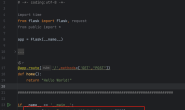-
。左边是mongodb查询语句,右边是sql语句 -
db.users.find() –> select * from users -
db.users.find({"age" : 27}) –> select * from users where age = 27 -
db.users.find({"username" : "joe", "age" : 27}) –> select * from users where "username" = "joe" and age = 27 -
db.users.find({}, {"username" : 1, "email" : 1}) –> select username, email from users -
db.users.find({}, {"username" : 1, "_id" : 0}) // no case // 即时加上了列筛选,_id也会返回;必须显式的阻止_id返回 -
db.users.find({"age" : {"$gte" : 18, "$lte" : 30}}) –> select * from users where age >=18 and age <= 30 // $lt(<) $lte(<=) $gt(>) $gte(>=) -
db.users.find({"username" : {"$ne" : "joe"}}) –> select * from users where username <> "joe" -
db.users.find({"ticket_no" : {"$in" : [725, 542, 390]}}) –> select * from users where ticket_no in (725, 542, 390) -
db.users.find({"ticket_no" : {"$nin" : [725, 542, 390]}}) –> select * from users where ticket_no not in (725, 542, 390) -
db.users.find({"$or" : [{“ticket_no” : 725}, {“winner” : true}]}) –> select * form users where ticket_no = 725 or winner = true -
db.users.find({"id_num" : {"$mod" : [5, 1]}}) –> select * from users where (id_num mod 5) = 1 -
db.users.find({"$not": {"age" : 27}}) –> select * from users where not (age = 27) -
db.users.find({"username" : {"$in" : [null], "$exists" : true}}) –> select * from users where username is null // 如果直接通过find({"username" : null})进行查询,那么连带"没有username"的纪录一并筛选出来 -
db.users.find({"name" : /joey?/i}) // 正则查询,value是符合PCRE的表达式 -
db.food.find({fruit : {$all : [“apple”, “banana”]}}) // 对数组的查询, 字段fruit中,既包含"apple",又包含"banana"的纪录 -
db.food.find({"fruit.2" : "peach"}) // 对数组的查询, 字段fruit中,第3个(从0开始)元素是peach的纪录 -
db.food.find({"fruit" : {"$size" : 3}}) // 对数组的查询, 查询数组元素个数是3的记录,$size前面无法和其他的操作符复合使用 -
db.users.findOne(criteria, {"comments" : {"$slice" : 10}}) // 对数组的查询,只返回数组comments中的前十条,还可以{"$slice" : -10}, {"$slice" : [23, 10]}; 分别返回最后10条,和中间10条 -
db.people.find({"name.first" : "Joe", "name.last" : "Schmoe"}) // 嵌套查询 -
db.blog.find({"comments" : {"$elemMatch" : {"author" : "joe", "score" : {"$gte" : 5}}}}) // 嵌套查询,仅当嵌套的元素是数组时使用, -
db.foo.find({"$where" : "this.x + this.y == 10"}) // 复杂的查询,$where当然是非常方便的,但效率低下。对于复杂查询,考虑的顺序应当是 正则 -> MapReduce -> $where -
db.foo.find({"$where" : "function() { return this.x + this.y == 10; }"}) // $where可以支持javascript函数作为查询条件 - db.foo.find().sort({"x" : 1}).limit(1).skip(10); // 返回第(10, 11]条,按"x"进行排序; 三个limit的顺序是任意的,应该尽量避免skip中使用large-number
1. 基本查询:
构造查询数据。
> db.test.findOne()
{
"_id" : ObjectId("4fd58ecbb9ac507e96276f1a"),
"name" : "stephen",
"age" : 35,
"genda" : "male",
"email" : "stephen@hotmail.com"
}
–多条件查询。下面的示例等同于SQL语句的where name = "stephen" and age = 35
> db.test.find({"name":"stephen","age":35})
{ "_id" : ObjectId("4fd58ecbb9ac507e96276f1a"), "name" : "stephen", "age" : 35, "genda" : "male", "email" : "stephen@hotmail.com" }
–返回指定的文档键值对。下面的示例将只是返回name和age键值对。
> db.test.find({}, {"name":1,"age":1})
{ "_id" : ObjectId("4fd58ecbb9ac507e96276f1a"), "name" : "stephen", "age" : 35 }
–指定不返回的文档键值对。下面的示例将返回除name之外的所有键值对。
> db.test.find({}, {"name":0})
{ "_id" : ObjectId("4fd58ecbb9ac507e96276f1a"), "age" : 35, "genda" : "male", "email" : "stephen@hotmail.com" }
2. 查询条件:
MongoDB提供了一组比较操作符:$lt/$lte/$gt/$gte/$ne,依次等价于</<=/>/>=/!=。
–下面的示例返回符合条件age >= 18 && age <= 40的文档。
> db.test.find({"age":{"$gte":18, "$lte":40}})
{ "_id" : ObjectId("4fd58ecbb9ac507e96276f1a"), "name" : "stephen", "age" : 35,"genda" : "male", "email" : "stephen@hotmail.com" }
–下面的示例返回条件符合name != "stephen1"
> db.test.find({"name":{"$ne":"stephen1"}})
{ "_id" : ObjectId("4fd58ecbb9ac507e96276f1a"), "name" : "stephen", "age" : 35,"genda" : "male", "email" : "stephen@hotmail.com" }
–$in等同于SQL中的in,下面的示例等同于SQL中的in ("stephen","stephen1")
> db.test.find({"name":{"$in":[“stephen”,”stephen1″]}})
{ "_id" : ObjectId("4fd58ecbb9ac507e96276f1a"), "name" : "stephen", "age" : 35,"genda" : "male", "email" : "stephen@hotmail.com" }
–和SQL不同的是,MongoDB的in list中的数据可以是不同类型。这种情况可用于不同类型的别名场景。
> db.test.find({"name":{"$in":[“stephen”,123]}})
{ "_id" : ObjectId("4fd58ecbb9ac507e96276f1a"), "name" : "stephen", "age" : 35,"genda" : "male", "email" : "stephen@hotmail.com" }
–$nin等同于SQL中的not in,同时也是$in的取反。如:
> db.test.find({"name":{"$nin":[“stephen2″,”stephen1”]}})
{ "_id" : ObjectId("4fd58ecbb9ac507e96276f1a"), "name" : "stephen", "age" : 35,"genda" : "male", "email" : "stephen@hotmail.com" }
–$or等同于SQL中的or,$or所针对的条件被放到一个数组中,每个数组元素表示or的一个条件。
–下面的示例等同于name = "stephen1" or age = 35
> db.test.find({"$or": [{“name”:”stephen1″}, {“age”:35}]})
{ "_id" : ObjectId("4fd58ecbb9ac507e96276f1a"), "name" : "stephen", "age" : 35,"genda" : "male", "email" : "stephen@hotmail.com" }
–下面的示例演示了如何混合使用$or和$in。
> db.test.find({"$or": [{“name”:{“$in”:[“stephen”,”stephen1″]}}, {“age”:36}]})
{ "_id" : ObjectId("4fd58ecbb9ac507e96276f1a"), "name" : "stephen", "age" : 35,"genda" : "male", "email" : "stephen@hotmail.com" }
–$not表示取反,等同于SQL中的not。
> db.test.find({"name": {"$not": {"$in":[“stephen2″,”stephen1”]}}})
{ "_id" : ObjectId("4fd58ecbb9ac507e96276f1a"), "name" : "stephen", "age" : 35,"genda" : "male", "email" : "stephen@hotmail.com" }
3. null数据类型的查询:
–在进行值为null数据的查询时,所有值为null,以及不包含指定键的文档均会被检索出来。
> db.test.find({"x":null})
{ "_id" : ObjectId("4fd59d30b9ac507e96276f1b"), "x" : null }
{ "_id" : ObjectId("4fd59d49b9ac507e96276f1c"), "y" : 1 }
–需要将null作为数组中的一个元素进行相等性判断,即便这个数组中只有一个元素。
–再有就是通过$exists判断指定键是否存在。
> db.test.find({"x": {"$in": [null], "$exists":true}})
{ "_id" : ObjectId("4fd59d30b9ac507e96276f1b"), "x" : null }
4. 正则查询:
–MongoDB中使用了Perl规则的正则语法。如:
> db.test.find()
{ "_id" : ObjectId("4fd59ed7b9ac507e96276f1d"), "name" : "stephen" }
{ "_id" : ObjectId("4fd59edbb9ac507e96276f1e"), "name" : "stephen1" }
–i表示忽略大小写
> db.test.find({"name":/stephen?/i})
{ "_id" : ObjectId("4fd59ed7b9ac507e96276f1d"), "name" : "stephen" }
{ "_id" : ObjectId("4fd59edbb9ac507e96276f1e"), "name" : "stephen1" }
5. 数组数据查询:
–基于数组的查找。
> db.test.find()
{ "_id" : ObjectId("4fd5a177b9ac507e96276f1f"), "fruit" : [ “apple”, “banana”, “peach” ] }
{ "_id" : ObjectId("4fd5a18cb9ac507e96276f20"), "fruit" : [ “apple”, “kumquat”,”orange” ] }
{ "_id" : ObjectId("4fd5a1f0b9ac507e96276f21"), "fruit" : [ “cherry”, “banana”,”apple” ] }
–数组中所有包含banana的文档都会被检索出来。
> db.test.find({"fruit":"banana"})
{ "_id" : ObjectId("4fd5a177b9ac507e96276f1f"), "fruit" : [ “apple”, “banana”, “peach” ] }
{ "_id" : ObjectId("4fd5a1f0b9ac507e96276f21"), "fruit" : [ “cherry”, “banana”,”apple” ] }
–检索数组中需要包含多个元素的情况,这里使用$all。下面的示例中,数组中必须同时包含apple和banana,但是他们的顺序无关紧要。
> db.test.find({"fruit": {"$all": [“banana”,”apple”]}})
{ "_id" : ObjectId("4fd5a177b9ac507e96276f1f"), "fruit" : [ “apple”, “banana”, “peach” ] }
{ "_id" : ObjectId("4fd5a1f0b9ac507e96276f21"), "fruit" : [ “cherry”, “banana”, “apple” ] }
–下面的示例表示精确匹配,即被检索出来的文档,fruit值中的数组数据必须和查询条件完全匹配,即不能多,也不能少,顺序也必须保持一致。
> db.test.find({"fruit":[“apple”,”banana”,”peach”]})
{ "_id" : ObjectId("4fd5a177b9ac507e96276f1f"), "fruit" : [ “apple”, “banana”, peach” ] }
–下面的示例将匹配数组中指定下标元素的值。数组的起始下标是0。
> db.test.find({"fruit.2":"peach"})
{ "_id" : ObjectId("4fd5a177b9ac507e96276f1f"), "fruit" : [ “apple”, “banana”, peach” ] }
–可以通过$size获取数组的长度,但是$size不能和比较操作符联合使用。
> db.test.find({"fruit": {$size : 3}})
{ "_id" : ObjectId("4fd5a177b9ac507e96276f1f"), "fruit" : [ “apple”, “banana”, “peach” ] }
{ "_id" : ObjectId("4fd5a18cb9ac507e96276f20"), "fruit" : [ “apple”, “kumquat”,”orange” ] }
{ "_id" : ObjectId("4fd5a1f0b9ac507e96276f21"), "fruit" : [ “cherry”, “banana”,”apple” ] }
–如果需要检索size > n的结果,不能直接使用$size,只能是添加一个额外的键表示数据中的元素数据,在操作数据中的元素时,需要同时更新size键的值。
–为后面的实验构造数据。
> db.test.update({}, {"$set": {"size":3}},false,true)
> db.test.find()
{ "_id" : ObjectId("4fd5a18cb9ac507e96276f20"), "fruit" : [ “apple”, “kumquat”, “orange” ], "size" : 3 }
{ "_id" : ObjectId("4fd5a1f0b9ac507e96276f21"), "fruit" : [ “cherry”, “banana”, “apple” ], "size" : 3 }
–每次添加一个新元素,都要原子性的自增size一次。
> test.update({},{"$push": {"fruit":"strawberry"},"$inc":{"size":1}},false,true)
> db.test.find()
{ "_id" : ObjectId("4fd5a18cb9ac507e96276f20"), "fruit" : [ “apple”, “kumquat”, “orange”, “strawberry” ], "size" : 4 }
{ "_id" : ObjectId("4fd5a1f0b9ac507e96276f21"), "fruit" : [ “cherry”, “banana”, “apple”, “strawberry” ], "size" : 4 }
–通过$slice返回数组中的部分数据。"$slice":2表示数组中的前两个元素。
> db.test.find({},{"fruit": {"$slice":2}, "size":0})
{ "_id" : ObjectId("4fd5a18cb9ac507e96276f20"), "fruit" : [ “apple”, “kumquat” ]}
{ "_id" : ObjectId("4fd5a1f0b9ac507e96276f21"), "fruit" : [ “cherry”, “banana” ]}
–通过$slice返回数组中的部分数据。"$slice":-2表示数组中的后两个元素。
> db.test.find({},{"fruit": {"$slice":-2}, "size":0})
{ "_id" : ObjectId("4fd5a18cb9ac507e96276f20"), "fruit" : [ “orange”, “strawberry” ] }
{ "_id" : ObjectId("4fd5a1f0b9ac507e96276f21"), "fruit" : [ “apple”, “strawberry” ] }
–$slice : [2,1],表示从第二个2元素开始取1个,如果获取数量大于2后面的元素数量,则取后面的全部数据。
> db.test.find({},{"fruit": {"$slice":[2,1]}, "size":0})
{ "_id" : ObjectId("4fd5a18cb9ac507e96276f20"), "fruit" : [ “orange” ] }
{ "_id" : ObjectId("4fd5a1f0b9ac507e96276f21"), "fruit" : [ “apple” ] }
6. 内嵌文档查询:
–为后面的示例构造测试数据。
> db.test.find()
{ "_id" : ObjectId("4fd5ada3b9ac507e96276f22"), "name" : { "first" : "Joe", "last" : "He" }, "age" : 45 }
–当嵌入式文档为数组时,需要$elemMatch操作符来帮助定位某一个元素匹配的情况,否则嵌入式文件将进行全部的匹配。
–即检索时需要将所有元素都列出来作为查询条件方可。
> db.test.findOne()
{
"_id" : ObjectId("4fd5af76b9ac507e96276f23"),
"comments" : [
{
"author" : "joe",
"score" : 3
},
{
"author" : "mary",
"score" : 6
}
]
}
> db.test.find({"comments": {"$elemMatch": {"author":"joe","score":{"$gte":3}}}}
{ "_id" : ObjectId("4fd5af76b9ac507e96276f23"), "comments" : [ { “author” : “joe”, “score” : 3 }, { “author” : “mary”, “score” : 6 } ] }
7. 游标:
数据库使用游标来返回find()的执行结果,客户端对游标可以进行有效的控制,如:限定结果集的数量、跳过部分结果、基于任意键的任意方向的排序等。
下面的例子将用于准备测试数据。
> db.testtable.remove()
> for (i = 0; i < 10; ++i) {
… db.testtable.insert({x:i})
… }
我们可以通过cursor提供的hasNext()方法判断是否还有未读取的数据,再通过next()方法读取结果集中的下一个文档。如:
> var c = db.testtable.find()
> while (c.hasNext()) {
… print(c.next().x)
… }
0
1
2
3
4
5
6
7
8
9
当调用find()的时候,shell并不立即查询数据库,而是等待真正开始要求获得结果的时候才发送查询,这样在执行之前可以给查询附加额外的选项。几乎所有的游标方法都返回本身,因此可以像下面这样将游标的方法链式组合起来。如:
> var c1 = db.testtable.find().sort({"x":1}).limit(1).skip(4);
> var c2 = db.testtable.find().limit(1).sort({"x":1}).skip(4);
> var c3 = db.testtable.find().skip(4).limit(1).sort({"x":1});
此时,查询并未执行,所有这些函数都是在构造查询,当执行下面的语句时,查询将被真正执行,
> c.hasNext()
查询被发送到服务器,MongoDB服务器每次将返回一批数据,当本批被全部迭代后再从服务器读取下一批数据,直至查询结果需要的数据被全部迭代。
对于上面的示例,limit(1)表示输出结果仅为一个,如果小于1,则不输出,即limit(n)函数限定的是最多输出结果。skip(4)表示跳过查询结果中的前4个文档,如果结果小于4,则不会返回任何文档。sort({"x":1})用于设定排序条件,即按照x键以升序(1)的方式排序,如果需要降序排序可以改为:sort({"x":-1})。sort也可以支持多键排序,如:sort({username:1, age:-1})即先按照username进行升序排序,如果username的值相同,再以age键进行降序排序。这里需要指出的是,如果skip过多的文档,将会导致性能问题。
如需转载请注明: 转载自26点的博客
本文链接地址: Mongodb的操作mysql对照解释
转载请注明:26点的博客 » Mongodb的操作mysql对照解释


